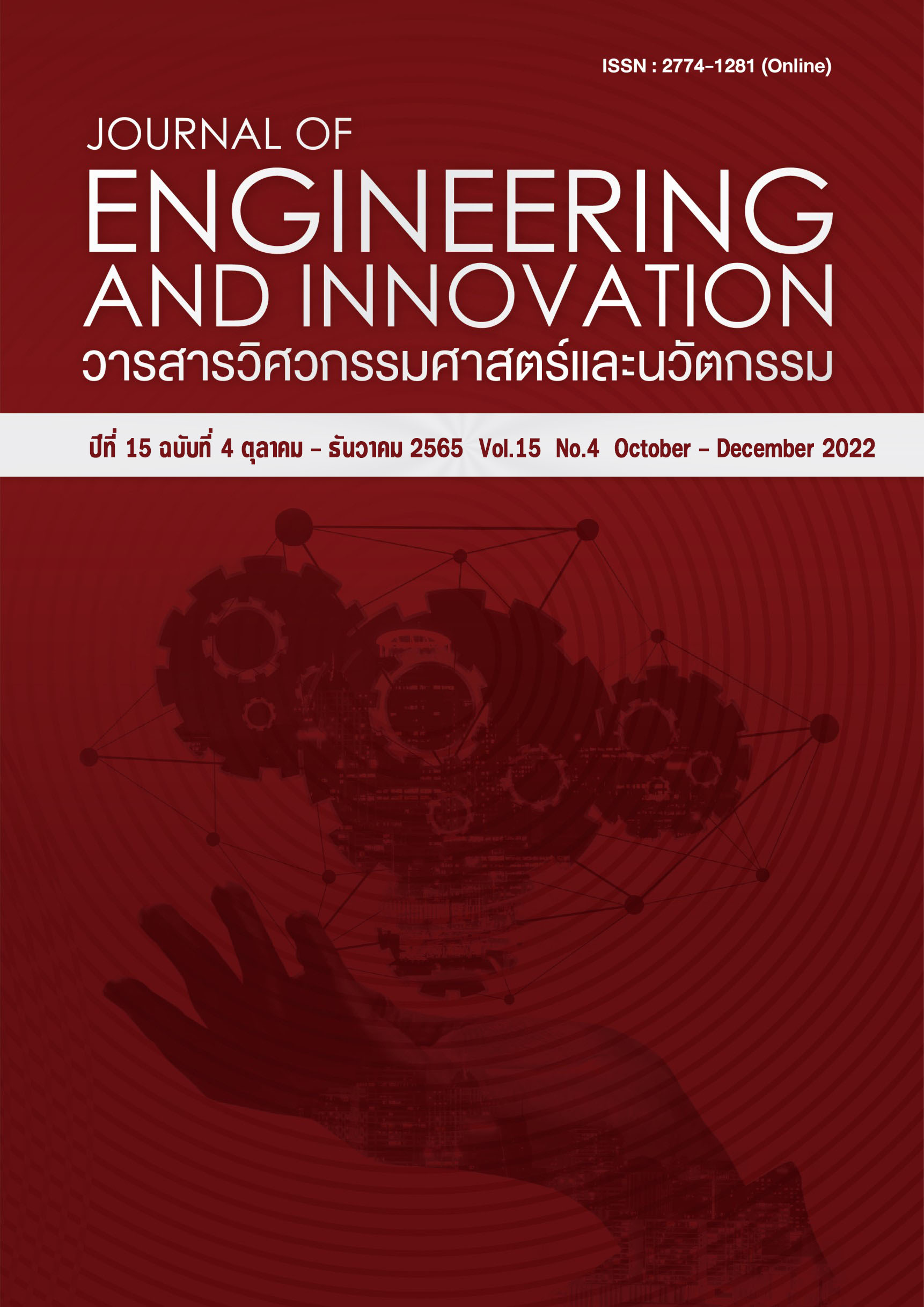ความถ่วงจำเพาะและขนาดของลูกบอลลอยน้ำที่ให้ประสิทธิภาพสูงต่อการลดการระเหยจากผิวน้ำเปิด
Main Article Content
บทคัดย่อ
การลดอัตราการระเหยจากอ่างเก็บน้ำโดยใช้วัสดุลอยน้ำ เช่น ลูกบอลพลาสติกลอยน้ำ เป็นวิธีการที่ได้รับความนิยมมากขึ้น เพื่อลดอัตราการสูญเสียน้ำจากการระเหยจากผิวน้ำเปิดของอ่างเก็บน้ำหรือสระเก็บน้ำ วัตถุประสงค์ของการศึกษานี้ คือการทดลองในสนามเพื่อหาระยะการจมหรือ ความถ่วงจำเพาะ (ถ.พ.) ของลูกบอล และขนาดเส้นผ่าศูนย์กลางของลูกบอลลอยน้ำที่มีประสิทธิภาพในการลดอัตราการระเหยได้มากที่สุด การทดลองดำเนินการที่ หน่วยผลิตน้ำประปา ส่วนอาคารสถานที่ มหาวิทยาลัยเทคโนโลยีสุรนารี โดยใช้อ่างพลาสติกจำนวน 4 อ่าง ซึ่งประกอบด้วยอ่างควบคุม 1 อ่างและอ่างทดลอง 3 อ่าง โดยควบคุมปัจจัยภายนอกให้เหมือนกัน การทดลองชุดที่ 1 ที่ขนาดลูกบอลเท่ากันที่ 7.5 เซนติเมตร พบว่าลูกบอลที่มีระยะการจมร้อยละ 30 หรือ ถ.พ. เท่ากับ 0.0203 มีประสิทธิภาพลดอัตราการะเหยสูงสุดที่ ร้อยละ 67 (เปรียบเทียบระหว่าง ร้อยละ 15 30 และ 50) การทดลองชุดที่ 2 ที่ขนาดลูกบอลเท่ากันที่ 7.5 เซนติเมตร พบว่าลูกบอลที่มีระยะการจมร้อยละ 35 หรือ ถ.พ. เท่ากับ 0.0260 มีประสิทธิภาพการลดอัตราการะเหยสูงสุดที่ ร้อยละ 67 (เปรียบเทียบระหว่าง ร้อยละ 25 35 และ 40) เมื่อนำผลการทดลองทั้งสองชุดมารวมกันเพื่อเปรียบเทียบประสิทธิภาพการลดการระเหยสูงสุด พบว่าลูกบอลที่มีระยะการจมที่ร้อยละ 35 มีประสิทธิภาพการลดอัตราการะเหยสูงสุด หลังจากนั้นได้ทำการทดลองชุดที่ 3 เพื่อศึกษาขนาดของลูกบอลที่มีผลต่อประสิทธิภาพของการลดการระเหย ได้ควบคุมระยะการจมที่ร้อยละ 35 โดยใช้ลูกบอลขนาดเส้นผ่าศูนย์กลาง 7.5 12.5 และ 17.5 เซนติเมตร พบว่าลูกบอลขนาดเส้นผ่านศูนย์กลาง 7.5 เซนติเมตร มีประสิทธิภาพการลดอัตราการะเหยสูงสุดที่ ร้อยละ 55 ผลการศึกษานี้จะเป็นแนวทางในผลิตลูกบอลที่มีขนาดและค่าถ.พ. ที่เหมาะสมต่อการนำไปใช้ลดการระเหยอย่างมีประสิทธิภาพ ในอ่างเก็บน้ำขนาดใหญ่ได้ต่อไป
Article Details
เอกสารอ้างอิง
Prime E, Leung A, Tran D, Gill H, Solomon D, Qiao G, et.al. New technology to reduce evaporation from large water storage. Australian Government National Water Commission; 2012.
Al-Saud MI. Reduction of evaporation from water surfaces-preliminary assessment for Riyadh Region, Kingdom of Saudi Arabia. Research Journal of Soil and Water Management. 2010; 1, 5-9.
Yao X, Zhang H, Lemckert C, Brook A, Schouten P. Evaporation reduction by suspended and floating covers: Overview, modelling and efficiency. Urban Water Security Research Alliance Technical Report No.28; 2010.
Alvarez VM, Baille A, Martínez, JMM, González-Real, MM. Efficiency of shading materials in reducing evaporation from free water surfaces. Agricultural water Management. 2006; 84(3), 229 -239.
Hassan MM, Peirson WL, Neyland BM, Fiddis, NM. Evaporation mitigation using floating modular devices. Journal of Hydrology. 2015; 530: 742-750.
Han KW, Shi KB, Yan XJ. Evaporation loss and energy balance of agricultural reservoirs covered with counterweighted spheres in arid region. Agricultural Water Management. 2020; 238: 106227.
Segal L, Burstein L. Retardation of water evaporation by a protective float. Water Resour Manage. 2010; 24: 129–137, DOI 10.1007/s11269-009-9440-3.
Rezazadeh A, Akbarzadeh P, Aminzadeh M. The effect of floating balls density on evaporation suppression of water reservoirs in the presence of surface flows. Journal of Hydrology. 2020; 591: 125323.
Pirrotta DC. Are “Shade Balls” shady science in our world: certainty and controversy (SC200), 2016. Available from http://sites.psu.edu/siowfa16/2016/09/04/are-shade-balls-shady/.
อารียา ฤทธิมา, กิตติพัฒน์ สาลีกิจ, กฤตยา สมานวงศ์รักษ์, พรรณทิพา ศรีธรรมมา, อิทธิพล ชีรนรวนิชย์. การศึกษาการสูญเสียนํ้าจากการระเหยของอ่างเก็บนํ้าขนาดกลางและขนาดเล็กในประเทศไทย. วิศวกรรมสารฉบับวิจัยและพัฒนา. 24 (1); 2556: 27-36.
เกศวรา สิทธิโชค, ไชยาพงษ์ เทพประสิทธิ์. การประยุกต์ใช้วัสดุทางกายภาพและชีวภาพคลุมผิวน้ำเพื่อลดอัตราการระเหยของน้ำในแหล่งกักเก็บน้ำขนาดเล็ก. วารสารวิจัยและพัฒนา มจธ. 44(1); 2564: 45-59
ทรงกฎ อุตรา วิทยาศาสตร์พอลิเมอร์. กรุงเทพ: โอ. เอส. พริ้นติ้ง เฮ้าส์; 2560.

